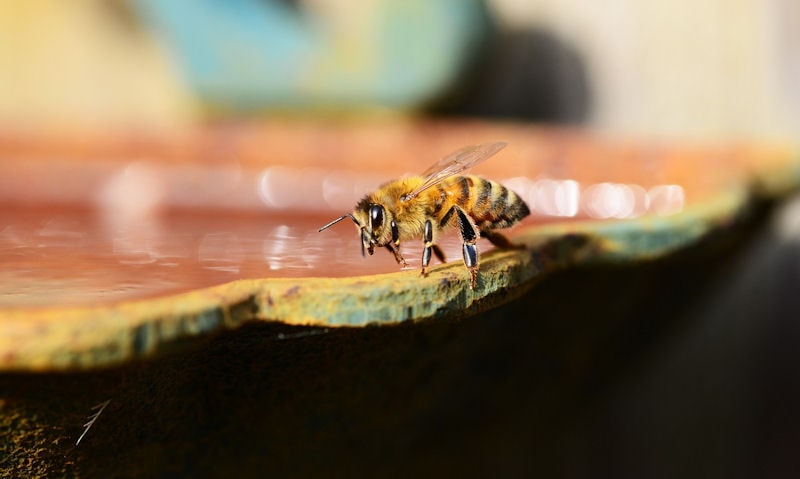How to keep Bees away from bird bath
Birds can continue to use a bird bath with bees present although with bird baths hard to attract wild birds to as it is, you don't want to risk losing any visiting birds.
How to keep bees away from a bird bath is to simply give them their own source of water, setup away from the bird bath being swarmed by bees. Keep it shallow to prevent bees drowning while offering an addition plate of homemade nectar to get their attention. Keep bird bath water moving as to stop bees landing.
Few bees can be allowed to continue drinking next to wild birds in a bird bath, although any sign of disturbance by birds then its time to kick off bees.
Its vital to help bees as they sustain the wild by pollinating the countryside, thus this isn't to say you mustn't prioritize birds over bees more.
Why not keep bees happy by providing them their own source of fresh water. It can be on a plate with a little water - plus a plate next to it with sugar water - while a bee feeder used by professional beekeepers can be used to slowly filter out water to bees.
How to get rid of bees in a bird bath once they swarm can be a little more difficult that's for sure - as its hard to divert wildlife to a new feeding ground or water source location once they found a reliable source of their own.
I will suggest you provide their own water source regardless by increasing the likelihood of them finding it by using multiple water source locations.
All of which can have their own nectar source next to it just to prevent a swarm of bees taking over your bird bath.
How you provide water for bees must be done in a safe and controlled environment; only offer bees water if you can absolutely prevent them from drowning as they collect water.
Give Bees their own water source
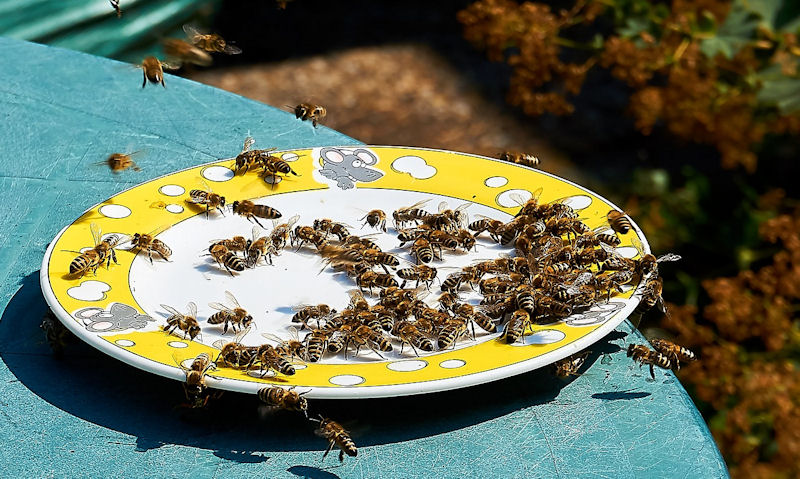
Why bees are invading bird bath space is because they are thirsty, its as simple at that so you can do something about it.
Don't let bees suffer as you attempt keep bees away from your bird bath, as to offer bees their own water source will benefit you - which will preferably be water added to a vibrant dish, different to the birds own colorful bird bath.
Want to keep bees of your bird bath?... then simply provide bees fresh water that is out of the way of the bird bath.
Prioritize where to place a bird bath in your yard as you normally do, all while finding a location where to setup bees own water. You'd want it to be visible of course while preferably locating it in an area where bees must pass over.
What you can use to add fresh water in is a unwanted ceramic dinner plate that can keep the water shallow to prevent bees drowning.
Its probably going to be a white dinner plate which is good but any plate with flowers or color on it is sure to grab bees attention.
Locate the plate on a flat surface that is visible to bees in the air, while keeping it in full sun as shade can obstruct the plate filled with water.
Professional beekeepers setup multiple bee feeders, which is essentially a plastic bottle that filters water out of the bottom - in which they are available for you to buy online.
Attract Bees to sweet water
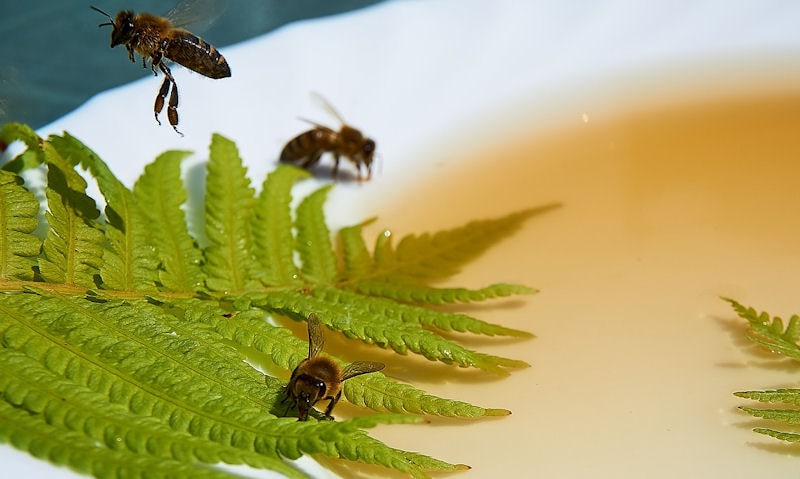
You know what, bees may insist on coming to your bird bath regardless of a bee feeder or many setup elsewhere in your yard.
If the issue is severe then continue to read on, however if only a few bees make it to the bird bath still then rest assured it won't be too much of a nuisance to common backyard birds currently arriving on the bird bath.
With that in mind I really do recommend you continue to offer bees multiple plain tap water resources scattered about in your yard. Bees need to drink water thus a water source must remain in place at all times.
Furthermore, what can be an effective way of making sure bees are attracted to your water source setup away from your bird bath, is to provide a plate of sugar water.
How to get rid of bees on a hummingbird feeder is to divert bees attention to their own nectar source - of which this sugar water is an homemade nectar and can deter bees off the bird bath - much as it does on a hummingbird feeder.
To keep it safe please follow a proper nectar recipe that includes one-part sugar to four-parts water. Never add food coloring or dye while avoid using more sugar than is needed. If nectar feeding birds decide to feed on it, it can become dangerous.
Offer bees their own water source in a dinner plate while alongside this plate should be a second plate filled with a shallow source of sugar water.
Keep water shallow
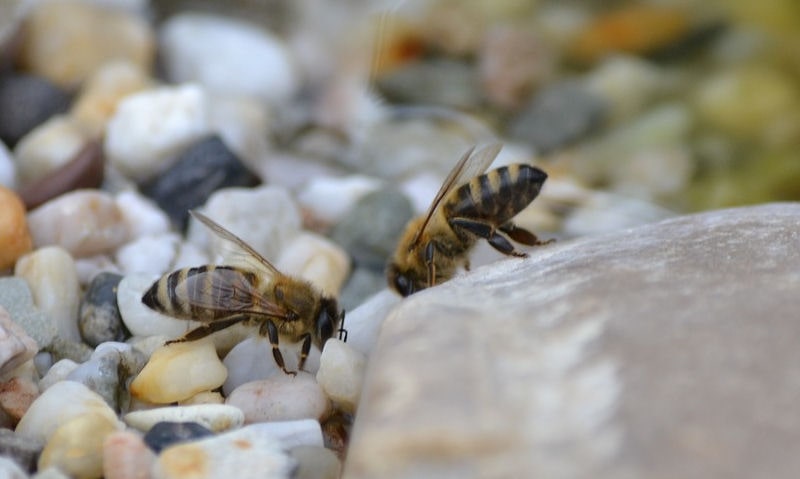
Despite your efforts to keep bees away from the bird bath its absolutely possible bees will continue to use your bird bath still.
We must protect our bees as best we can regardless of them disturbing birds or keeping them off our bird baths. So I ask you to keep these pollinating insects safe by keeping the bird bath water shallow.
If you decide to offer them plain tap water and therefore a plate of homemade nectar, only fill it 1-1/16 of an inch - which is about 1 to 2 millimeters only.
Bees need to be able to enter the water source safely while remaining out of the water when they do.
Bird baths can be up to 2 inches deep which of course can lead to all bees getting in to trouble. Good news is you can line the base of the bird bath with pebbles to benefit birds, yet a handful of flat rocks can acts as bird perches - all of which can allow bees to enter the water to drink safely.
Bees seen to swarm your bird bath can unfortunately lead to bees bodies floating in the water.
Whenever offering a water source to bees then do be sure to keep it shallow, or setup areas that can allow bees to drink water out of pockets of water - such as water under a lining of pebbles.
Move water in main bird bath
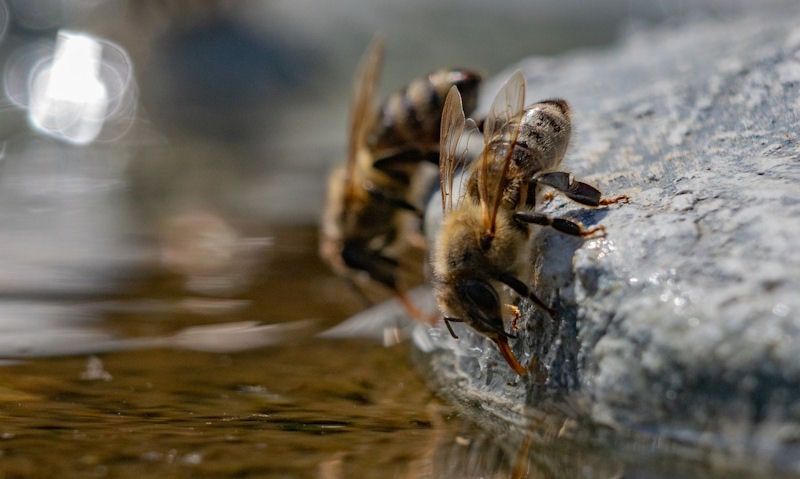
Bees tend to swarm a water source that is calm, steady with no splashing or waves potentially leading to bees getting in trouble.
What you can do then to keep bees off your bird bath is to keep the water moving.
How to keep bird bath water moving isn't a waste of time or resources; in fact moving water can attract birds to the reflection of the ripples - while any device used to create running water which birds are attracted to - can include the sound of running water.
What you can do then is setup a solar powered bird bath fountain feature, or why not use what is called The Wiggler - which basically makes ripples in the water.
Ripples of which will land on the rim of the bird bath while preventing bees from landing to drink.
Fountain bird bath water is unsettled at all times thus bees may find it difficult to get a foot hold to drink.
Solutions to keep bird bath water not only moving but to disturb bees as they are kept off can benefit birds yet be a nuisance to bees at the same time.
Despite that, please only take this advise in a way to deter birds rather than what can lead to bees drowning or indeed going without. Its still vital you provide bees their own water source which they may eventually use if they can't access bird bath water.
Summary
Its simple, how to keep bees away from a bird bath is by simply giving them their own source of easily accessible fresh water.
Gives bees a shallow plate of water on an unwanted dinner plate. Access to water must be made easy while the plate must remain visible to bees as they pass over on the way to your bird bath.
If bees can't be tempted to drink out of a plate of water which you setup especially for them, you can always setup a plate of nectar beside the drinking water plate. Bees can be attracted to sugar thus homemade nectar is sure to grab their attention.
Keep the plate of water or sugar water very shallow with perhaps pockets of water rather than anything more substantial.
At this time its imperative you prevent honey bees drowning in an effort to quench their thirst in hotter times.
What else you can do to keep bees well off your bird bath is to be sure bees can't land on an area that isn't hit with water.
What you do is setup a bird bath fountain feature or what is called The Wiggler which will create splashing and, or ripples in the bird bath that can in itself prevent bees landing.
Regardless of your choice to prevent bees drinking at your bird bath, please do make sure you offer a source of fresh water of their own so bees can't go without.
